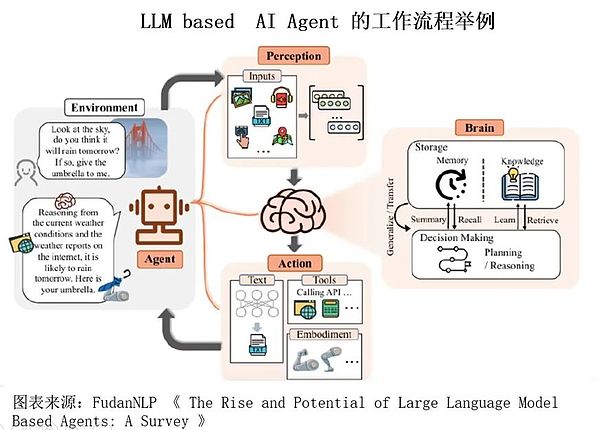
Introduction
Although decentralized AI has many advantages, it also faces many risks and challenges. As the third article in this series, this article will analyze these challenges for you and look forward to the future development direction of decentralized AI.
We also welcome entrepreneurs and project parties in this direction to contact us.
Development opportunities of AI Agent
AI Agent is the natural evolution of large models. By introducing memory mechanism, task decomposition and planning capabilities, AI Agent can perceive the environment, make decisions independently and perform complex tasks.
Although existing large models are capable of generating text and solving problems, they are not yet equipped Complete mission planning and execution capabilities. AI Agent will make up for this shortcoming and improve AI's performance in complex tasks.
If AI is nuclear energy, then it should not only be in the hands of a few people. Decentralized AI Agent will ensure the fairness and transparency of AI technology through blockchain and encryption technology.
In the future agent society, decentralized AI will become an inevitable trend to solve the problems faced by the existing centralized AI system.
Development opportunities for data annotation:
Data preparation includes data collection, cleaning, annotation and Enhanced, AI's diversified demand for data has increased its reliance on high-precision and highly customized data annotation. The lengthy work cycle and high labor cost of data annotation have restricted the development of the AI industry.
Web3 can access a large number of AI data collection and annotation workers in various regions around the world through economic incentive mechanisms, allowing them to benefit from data contributions.
Case: Data trading market Ocean Protocol
Operating mechanism
•Providers: Data providers can issue and sell their own data Tokens to earn income
•Consumers: Purchase or earn the required data tokens to gain access.
•Marketplaces: Refers to an open, transparent and fair data trading market provided by Ocean Protocol or a third party, which can connect providers and consumers around the world and provide data tokens in multiple types and fields.
< p style="text-align: left;">•Network: refers to the A decentralized network layer provided.•Curator: refers to the role in an ecosystem responsible for screening, managing, and reviewing data sets. , they are responsible for reviewing the source, content, format, and license information of the data set to ensure that the data set meets standards and can be trusted and used by other users.
•Verifier: Refers to the role in an ecosystem responsible for verifying and auditing data transactions and data services.
Summary: AI Agent and Decentralized data annotation is currently two of the more popular directions in DeAI, and many entrepreneurial teams are developing them.
The risks and risks faced by decentralized AI. Challenge
Limitations of Web3’s AI empowerment: Due to the limited number of Web3 encryption users, the scope of the economic incentive mechanism is smaller, which limits the rapid development of decentralized AI and requires more. user engagement and acceptance
Challenges of zero-knowledge proof technology: issues such as quantification accuracy, hardware requirements, and adversarial attacks. Zero-knowledge proof technology (ZKP) has long-term significance in achieving the verifiability of models, but it still faces technical challenges Difficulties and Implementation Challenges
The attraction of cost advantages: If the supply of computing resources in the market is eased, the value and cost advantages of the decentralized computing network will be weakened. This requires decentralized AI to continuously improve efficiency and reduce costs in order to Keep it competitive
Efficiency and cost issues of combining AI and cryptography: The efficiency of using zero-knowledge proof technology or fully homomorphic encryption (FHE) technology to perform private computing tasks is much lower than plaintext execution. Due to the high computing requirements of AI, adding cryptography The technology will further increase costs and may be difficult to implement.
AI's deep fake problem: The communication bottleneck problem in AI model training is significant. Frequent exchange of model parameters and gradient information will consume a lot of network bandwidth and generate high communication overhead. At the same time, the synchronization problem of each node will also affect the training results. Impact requires frequent data verification and synchronization operations
The popularity of AI has led to an increase in the risk of deep fakes. In the cross-empowerment scenario of Web3 and AI, it is necessary to prevent the risk of AI counterfeiting.
The future development direction of decentralized AI
Model layer: With AI Agents become more common and users will rely on AI in the future Agent helps you complete tasks and is the key to connecting the model layer and the application layer. The diversified platform of models is gradually formed, and the cost of large models is declining. It still takes time to develop "dark horse" applications.
Training layer: It is possible to implement decentralized training of AI models, but since the inference requirements are much greater than the training requirements, the training layer will rely more on centralized computing power.
Computing power layer: Decentralized computing power effectively reduces GPU usage costs, and enterprise-level GPUs meet current computing power needs. In the future, consumer GPUs will be useful when end-side models are implemented.
Data layer: public data acquisitionIt is becoming more and more difficult to obtain data, and decentralized data collection and data annotation will become an important way to source and process AI model data in the future.
Conclusion
Decentralized AI is an emerging technology trend. Although the road is full of challenges, but its development potential is huge. With the continuous advancement of technology and the gradual maturity of the market, decentralized AI is expected to play a greater role in the future. We need to continue to pay attention to these challenges and find innovative solutions to promote the development of decentralized AI. Among them, we believe that decentralized AI has its place at the four levels of model, training, data, and computing power. In particular, DeAI is one of the most visible and value-producing directions.











